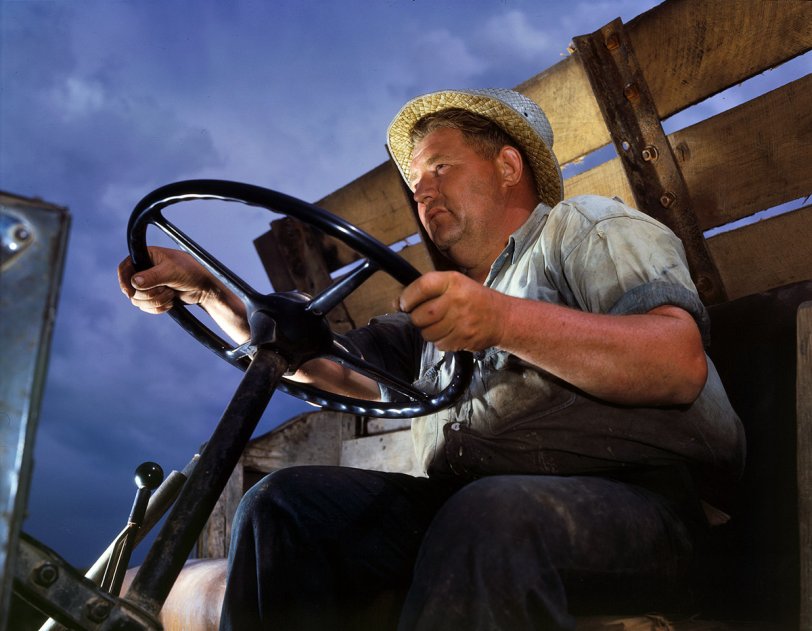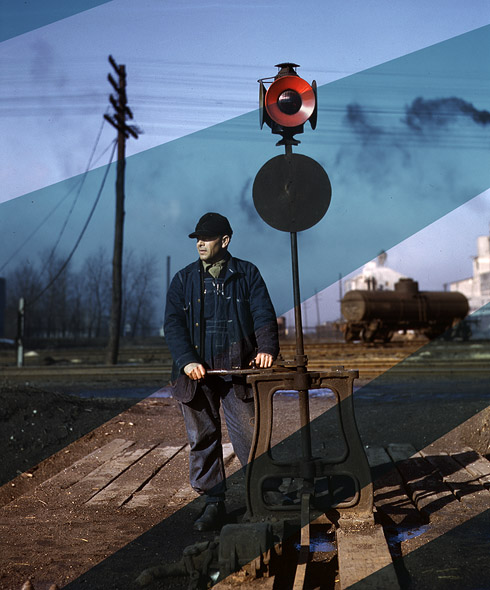


Framed or unframed, desk size to sofa size, printed by us in Arizona and Alabama since 2007. Explore now.
Shorpy is funded by you. Patreon contributors get an ad-free experience.
Learn more.

- Tough Guys
- Lost in Toyland
- And without gloves
- If I were a blindfolded time traveler
- Smoke Consumer Also Cooks
- Oh that stove!
- Possibly still there?
- What?!?
- $100 Reward
- Freeze Frame
- Texas Flyer wanted
- Just a Year Too Soon
- WWII -- Replacing men with women at the railroad crossing.
- Yes, Icing
- You kids drive me nuts!
- NOT An Easy Job
- I wonder
- Just add window boxes
- Icing Platform?
- Indiana Harbor Belt abides
- Freezing haze
- Corrections (for those who care)
- C&NW at Nelson
- Fallen Flags
- A dangerous job made worse
- Water Stop
- Passenger trains have right of way over freights?
- Coal
- Never ceases to amaze me.
- Still chuggin' (in model form)
Print Emporium
Time to Make the Donuts

June 1942. Truck driver at the Tennessee Valley Authority's Douglas Dam. View full size. Amazing 4x5 Kodachrome transparency by Alfred Palmer.
Scanner?
Can anybody comment on the scanner used for these shots?
[There is no scanner. The LOC transparencies are digitized using a Sinar studio back, which is something like a regular digital camera (but without a light source, which the user has to supply along with a lens, if one is needed). Basically a giant CCD array that records an image in one to four exposures. - Dave.]
Original Kodachrome Film
We must remember that the original Kodachrome film was ASA 10 and very contrasty. It was hard to overexpose it! Kodachrome II (ASA 25) came out around 1960 and was far better.
These photographs are just so good! I can't tear myself away from the computer until I've seen them all. GREAT work, Dave.
Exposure
Dave,
Thanks for taking the time for your comprehensive reply. Although I have a Graflex Crown Graphic 4x5, I am resigned to using it with Ektachrome 100 EPP readyloads, as Kodachrome is nowadays available in 35 mm only. The Kodachrome goes in a Leica M6 TTL therefor and has to be sent to Kansas (the only remaining K14 lab in the world) for processing.
The original Delano slide looks underexposed by at least a full stop and certainly benefits from your post processing. If Delano exposed like this consistedly, I wonder why.
Keep up the good work!
[The darkness of some of these may have to do with the settings used by the contractors who digitize these for the LOC. They may be erring on the side of caution. You can usually extract a nice picture from the tiff of an underexposed sheet whereas with an overexposed image you are pretty much stuck with what you see. - Dave]
Color correction
Dave,
What color correction do you do to Kodachromes? Do 40s Kodachromes need any? I believe this particular emulsion should be good for something like 180 years when stored dry and dark.
BTW: Love this site and visit twice a day at least to see if there is something new. The photographs by Jack Delano that you put up made me buy 48 rolls of Kodachrome 64: great stuff while it lasts.
[Thanks. There was no color correcting for this one aside from hitting Auto Color in Photoshop, which will remove any color cast. Then there is usually a bit of tweaking with the Shadows and Highlights filter. One reason these look so nice is the large film size. The 4 by 5 inch Kodachrome sheets used to make these pictures have 18.4 square inches of usable surface area, which is 18 times as much as a 35mm film frame, which gives almost exactly one square inch. So there is a lot more information to work with. The archival tiffs for these images are from 130 to 200 mb in size. The Delano pictures tend to be underexposed and require a bit more tweaking. Below is a Delano shot with the before-and-after versions in alternating stripes. - Dave]

Amazing! It looks like a
Amazing!
It looks like a photo taken in a studio with a complex lighting setup. Or maybe a modern HDR photo. Hard to believe it was taken in the forties.
I love the color!
I love the color of these Kodachrome transparencies you're posting. Absolutely marvelous! Please post more if you got 'em.
[Glad you like them. For many if not most of the ones we are posting, this is the first time they've been seen in all their high-res, color-corrected glory. - Dave]
























On Shorpy:
Today’s Top 5